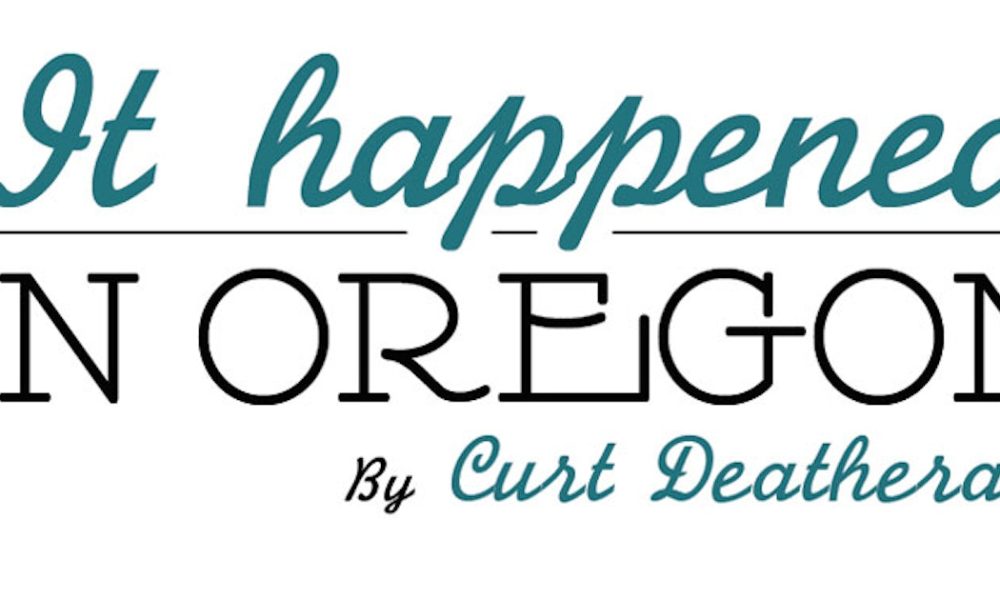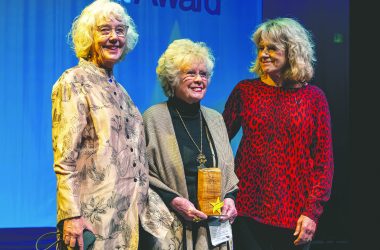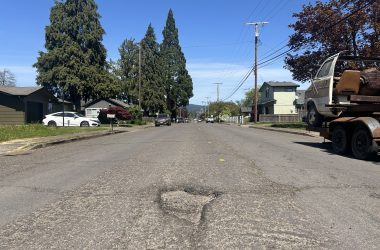
Street names can often give a glimpse into a town’s character or past, and the city of Creswell is no exception. Although any documentation in this area is practically non-existent, one street name gives a glimpse of the past. Mill Street, which runs parallel to Front Street, on the east side of the railroad tracks, offers a hint into the town’s rich history in the wood products industry.
The information contained in this article is based on the recollections of several local citizens who have been involved in the local wood products industry for an extended period of time. The information presented is as factual as possible. Thanks to Rod Davis, Wayne Bowers, Mike and Phil Newman, Don Satter and Martin Hartman for sharing their memories. Like the industry they provided information about, all of the aforementioned, with the exception of Mike Newman, have left us.
The earliest years of the timber industry are the most difficult to document. According to ”The Blue Valley: A History of Creswell,” the earliest area sawmill, perhaps the first in Lane County, was operated by E. P. Castleman in the Cloverdale area east of Creswell. That book also lists the names of other early sawmills, such as Creswell Planing Mill, McCubbins Lumber Company and McDaniels Planing Mill. These listings and others date to the early 1900s, and this listing is the only reference found to the early 20th century timber industry.
Several mills were located in the Bear Creek area, including the Petty Sawmill, Lower Brothers Sawmill and Gootch Brothers Sawmill. Not only did the Bear Creek area furnish logs to these mills but to numerous other mills as well.
In the mid 1930s, Harry Holt built a sawmill near the location of the former Bald Knob Land and Timber’s log yard. The mill ran until sometime in the late ’40s or early ’50s and was then leased to Bill Teague. Another sawmill, Crabb and Cartwright Lumber Company, reportedly relocated from Camas Swale Road to a location just north of the Holt mill. A veneer plant was built on South Mill Street about this time as the sawmills closed and were dismantled.
That veneer plant has had a number of owners or operators in its nearly 60-year history. It may have been started as a co-op operation, with Milwaukee Plywood and Door Company taking over operation shortly after it started up. Hub City Plywood, based in Albany, also ran the mill, as well as Leading Plywood, Georgia Pacific, which reportedly operated it as CresPly Plant #5 and Brand S Corporation.
Forrest Solomon, who was operating the Mazama veneer plant at Walker, sold that operation to Golden Veneer and bought the Creswell veneer plant from Brand S in 1969. It changed hands again in 1985, when it became Bald Knob Land and Timber. Pacific States Plywood was the last owner and operator of the veneer plant at that location.
During the 1940s, Gootch Brothers Sawmill on Bear Creek sent their rough-cut lumber to their planing mill on Mill Street, just north of the Holt and Crabb & Cartwright mills. After the lumber was planed, it was taken across the street to the railroad loading docks for shipment.
Sometime in the late ’40s, Nels Ohrling started Ohrling Lumber Company and Pacific Mill Company near the location of the Gootch Brothers’ planing mill. Ohrling’s mill complex also included a planing mill; it’s unknown if those planing mills were one in the same. Ohrling operated the mill for several years, and when he traveled to his native Norway, he leased the operation to the Teague Brothers. They operated it for a couple of years, until a torch used while changing saws in the edger started a pile of pitch covered sawdust on fire. The resulting inferno put the brothers out of business, as the sawmill was severely damaged. Upon his return from Norway, Ohrling put the mill and property up for sale.
Phil Newman had been salvage logging in the Bear Creek area in the early 1950s and had his portable sawmill set up near the Gootch Brothers Sawmill. In 1954, Newman purchased the burned mill, planing mill, two burners and property, nearly seven acres, from Ohrling for $29,000. He continued rough cutting the lumber at his portable mill, and trucked the lumber to his newly acquired planing mill for finishing and shipping.
Later in the ’50s, he moved the portable mill to the former Ohrling mill site and set it up there as a permanent mill. In addition to operating the sawmill and planing mill, Newman also did contract logging for other mills in the area. The operation became known as Newman Lumber and Logging. Newman operated until the late 1960s, until, as he put it, ”Gustina Brothers started using cull peelers for core in plywood, and my log supply was gone.”
The famed 1962 Columbus Day Storm wreaked havoc with several area mills. The burner at the veneer plant, operating at that time as Hub City Plywood, was nearly destroyed. The small burner at Newman’s planing mill was nearly destroyed as well, and the sawmill’s big burner required extensive repair.
Several pole and piling mills were located on both the north and south sides of Oregon Avenue on the east side of the railroad tracks. Lumber industry legend Warren Daugherty of Cottage Grove operated a pole yard that was located where the Dari-Mart store stands today.
Located further north on North Mill Street, across from the Post Office, was Gay Lumber and Timber Company. It was sold in the late ’40s or early ’50s and became known as Rees Lumber Company. It is not known when that mill closed.
Just west of town, where Florence Avenue intersects with Camas Swale Road, a steam-powered sawmill was located in the 1930s. The mill was originally operated by someone named Chambers or Chamberlin, who sold it to Marion Miller. Frank Kennedy later bought the mill, and he changed its power source from steam to a Caterpillar diesel engine. The mill closed in the mid to late 1950s.
A veneer drying and plywood layup plant was located on Butte Road, at the current location of Emerald Forest Products’ veneer drying plant. The plywood plant operated in the 1960s as RDI, Riviera Development Company, and later as CresPly, a division of Mazama Timber.
Numerous other sawmills operated in the immediate area, many of them small operations, and many of them for only short periods of time. Information on these numerous mills could not be located for inclusion in this article. Rod Davis said he can remember that in the early 1950s, there were over 30 mills operating within a five-mile radius of Creswell.
That is a far cry from what is operating in the Creswell area today. The veneer drying plant operated by Emerald Forest Products is the only one still in operation. Several small cut-up or resaw plants have operated locally in recent years, but none are operating today. Creswell Forest Products, which was located on Butte Road just north of Emerald and made mouldings and did some custom lumber cutting recently burned and is also out of business.
Many factors have contributed to the cutback in the wood products industry, not only locally, but regionally and nationally as well. Loss of timber supplies, automation, a downturn in the housing market compared to the post-World War II era and environmental concerns have all been contributing factors. But although its presence is not as noticeable today, the timber industry was a major factor in the development of Creswell in the 20th century.








